Abstract
The function of the hepatic component of the mononuclear phagocyte system (MPS) was investigated in the rat using N-ethylmaleimide (NEM)-treated erythrocytes and erythrocytes sensitized with a rat IgG2a monoclonal antibody (R2/15S) directed against the rat RT1Aa class I antigen. The clearance of the antibody-sensitized erythrocytes was biphasic, with the initial phase being rapid and complement dependent. This clearance was entirely hepatic and could be reduced or prevented by the infusion of cobra venom factor (CVF), complement fragments or small amounts of immune complexes, prepared either at equivalence or 10-fold antigen excess. NEM-treated cells were removed rapidly from the circulation of normal rats (t 1/2 6.2 +/- 0.4 min) and their clearance rate was not influenced by complement depletion. Most of the cells accumulated in the liver, although a small proportion (17%) was removed by the spleen. Immune complexes formed at equivalence or heat-aggregated human gamma globulin (HAGG) delayed the removal of these cells from the circulation, although significantly larger amounts of HAGG were required to do this. Antigen-excess immune complexes had no effect.
Full text
PDF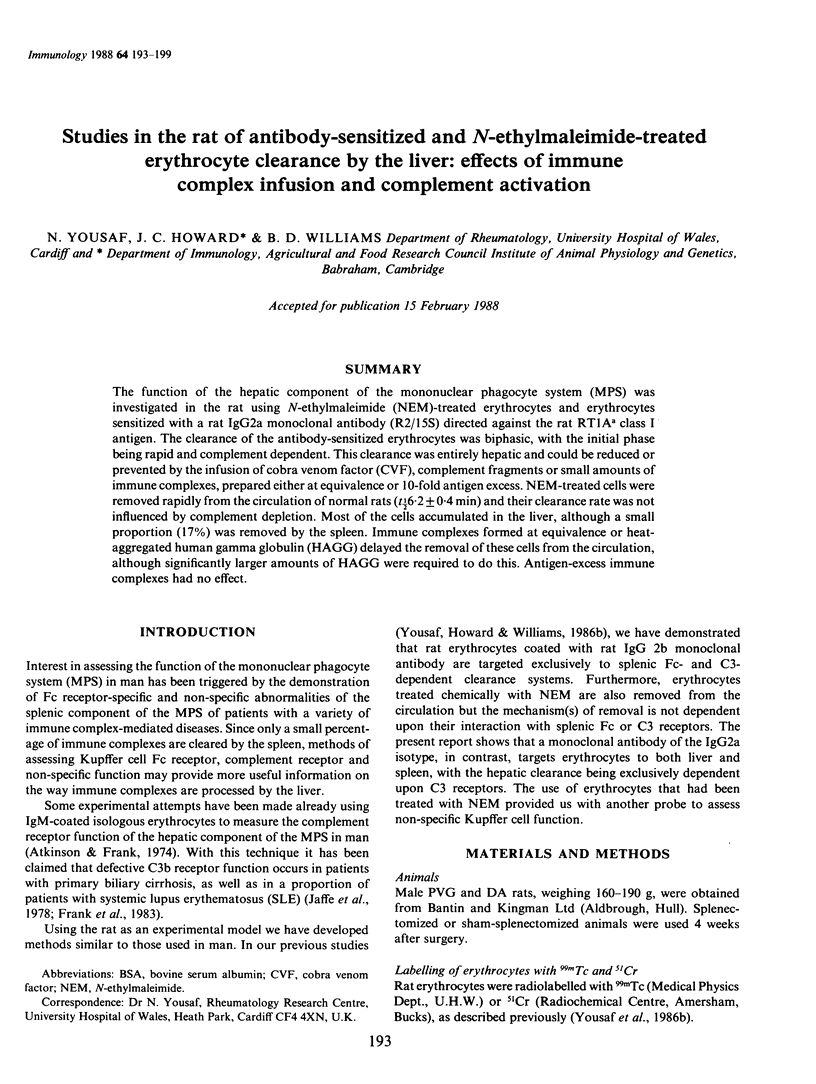
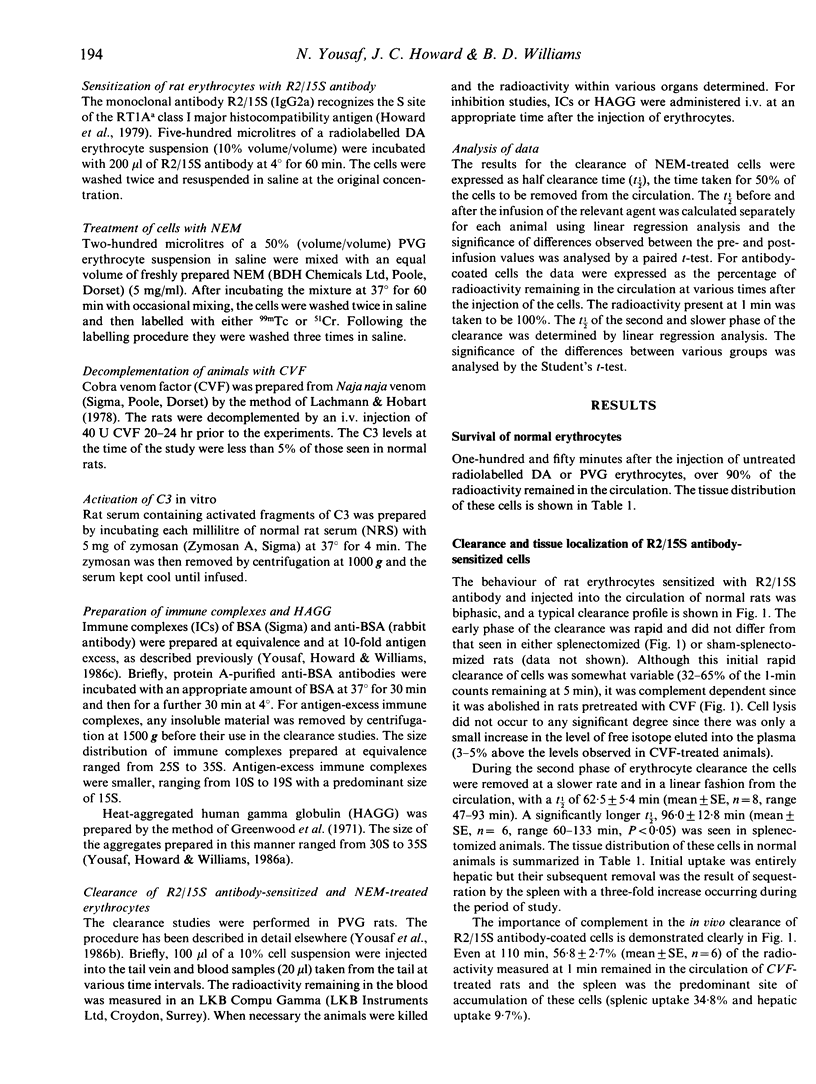

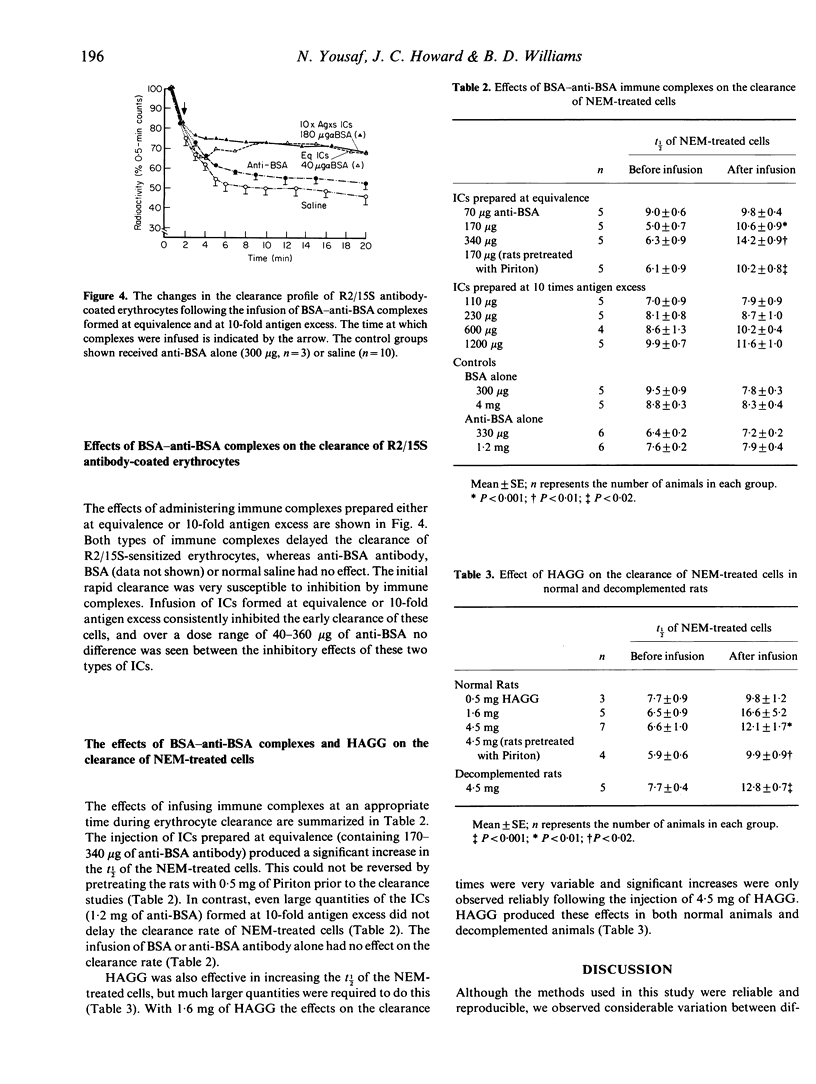

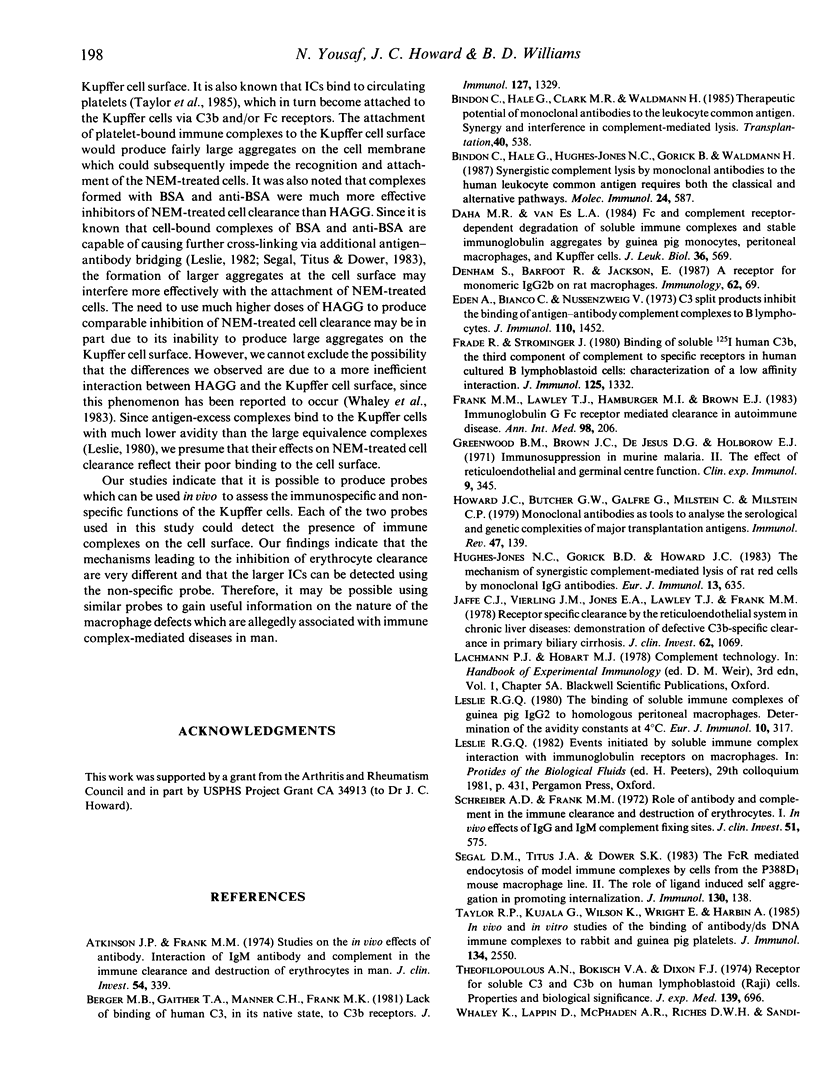
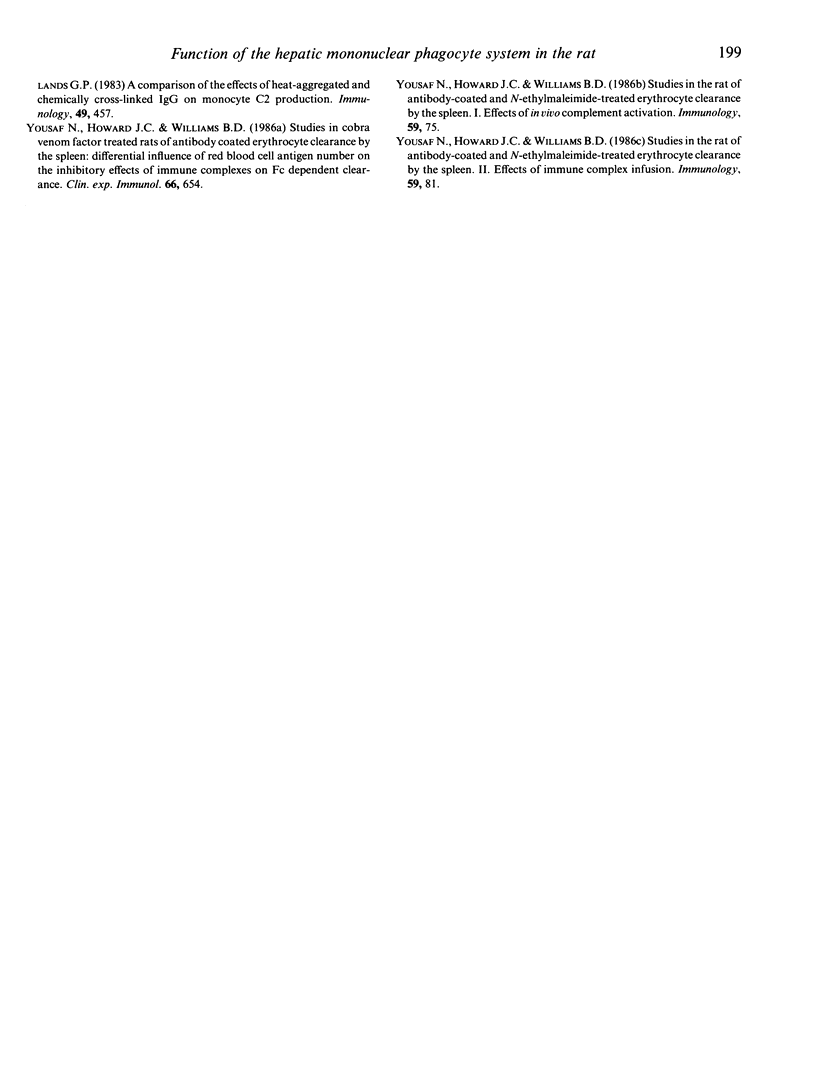
Selected References
These references are in PubMed. This may not be the complete list of references from this article.
- Atkinson J. P., Frank M. M. Studies on the in vivo effects of antibody. Interaction of IgM antibody and complement in the immune clearance and destruction of erythrocytes in man. J Clin Invest. 1974 Aug;54(2):339–348. doi: 10.1172/JCI107769. [DOI] [PMC free article] [PubMed] [Google Scholar]
- Berger M., Gaither T. A., Hammer C. H., Frank M. M. Lack of binding of human C3, in its native state, to C3b receptors. J Immunol. 1981 Oct;127(4):1329–1334. [PubMed] [Google Scholar]
- Bindon C. I., Hale G., Clark M., Waldmann H. Therapeutic potential of monoclonal antibodies to the leukocyte-common antigen. Synergy and interference in complement-mediated lysis. Transplantation. 1985 Nov;40(5):538–544. doi: 10.1097/00007890-198511000-00013. [DOI] [PubMed] [Google Scholar]
- Bindon C. I., Hale G., Hughes-Jones N., Gorick B., Waldmann H. Synergistic complement lysis by monoclonal antibodies to the human leukocyte common antigen requires both the classical and alternative pathways. Mol Immunol. 1987 Jun;24(6):587–594. doi: 10.1016/0161-5890(87)90039-3. [DOI] [PubMed] [Google Scholar]
- Daha M. R., van Es L. A. Fc- and complement receptor-dependent degradation of soluble immune complexes and stable immunoglobulin aggregates by guinea pig monocytes, peritoneal macrophages, and Kupffer cells. J Leukoc Biol. 1984 Nov;36(5):569–579. doi: 10.1002/jlb.36.5.569. [DOI] [PubMed] [Google Scholar]
- Eden A., Bianco C., Nussenzweig V., Mayer M. M. C3 split products inhibit the binding of antigen-antibody-complement complexes to B lymphocytes. J Immunol. 1973 May;110(5):1452–1453. [PubMed] [Google Scholar]
- Frade R., Strominger J. Binding of soluble 125I-human C3b, the third component of complement, to specific receptors in human cultured B lymphoblastoids cells: characterization of a low affinity interaction. J Immunol. 1980 Sep;125(3):1332–1339. [PubMed] [Google Scholar]
- Frank M. M., Lawley T. J., Hamburger M. I., Brown E. J. NIH Conference: Immunoglobulin G Fc receptor-mediated clearance in autoimmune diseases. Ann Intern Med. 1983 Feb;98(2):206–218. doi: 10.7326/0003-4819-98-2-218. [DOI] [PubMed] [Google Scholar]
- Greenwood B. M., Brown J. C., De Jesus D. G., Holborow E. J. Immunosuppression in murine malaria. II. The effect on reticulo-endothelial and germinal centre function. Clin Exp Immunol. 1971 Sep;9(3):345–354. [PMC free article] [PubMed] [Google Scholar]
- Howard J. C., Butcher G. W., Galfrè G., Milstein C., Milstein C. P. Monoclonal antibodies as tools to analyze the serological and genetic complexities of major transplantation antigens. Immunol Rev. 1979;47:139–174. doi: 10.1111/j.1600-065x.1979.tb00292.x. [DOI] [PubMed] [Google Scholar]
- Hughes-Jones N. C., Gorick B. D., Howard J. C. The mechanism of synergistic complement-mediated lysis of rat red cells by monoclonal IgG antibodies. Eur J Immunol. 1983 Aug;13(8):635–641. doi: 10.1002/eji.1830130806. [DOI] [PubMed] [Google Scholar]
- Jaffe C. J., Vierling J. M., Jones E. A., Lawley T. J., Frank M. M. Receptor specific clearance by the reticuloendothelial system in chronic liver diseases. Demonstration of defective C3b-specific clearance in primary biliary cirrhosis. J Clin Invest. 1978 Nov;62(5):1069–1077. doi: 10.1172/JCI109212. [DOI] [PMC free article] [PubMed] [Google Scholar]
- Leslie R. G. The binding of soluble immune complexes of guinea pig IgG2 to homologous peritoneal macrophages. Determination of the avidity constants at 4 degrees C. Eur J Immunol. 1980 May;10(5):317–322. doi: 10.1002/eji.1830100502. [DOI] [PubMed] [Google Scholar]
- Schreiber A. D., Frank M. M. Role of antibody and complement in the immune clearance and destruction of erythrocytes. I. In vivo effects of IgG and IgM complement-fixing sites. J Clin Invest. 1972 Mar;51(3):575–582. doi: 10.1172/JCI106846. [DOI] [PMC free article] [PubMed] [Google Scholar]
- Segal D. M., Titus J. A., Dower S. K. The FcR-mediated endocytosis of model immune complexes by cells from the P388D1 mouse macrophage line. II. The role of ligand-induced self-aggregation in promoting internalization. J Immunol. 1983 Jan;130(1):138–144. [PubMed] [Google Scholar]
- Taylor R. P., Kujala G., Wilson K., Wright E., Harbin A. In vivo and in vitro studies of the binding of antibody/dsDNA immune complexes to rabbit and guinea pig platelets. J Immunol. 1985 Apr;134(4):2550–2558. [PubMed] [Google Scholar]
- Theofilopoulos A. N., Bokisch V. A., Dixon F. J. Receptor for soluble C3 and C3b on human lymphoblastoid (RAJI) cells. Properties and biologocal significance. J Exp Med. 1974 Mar 1;139(3):696–711. doi: 10.1084/jem.139.3.696. [DOI] [PMC free article] [PubMed] [Google Scholar]
- Yousaf N., Howard J. C., Williams B. D. Studies in cobra venom factor treated rats of antibody coated erythrocyte clearance by the spleen: differential influence of red blood cell antigen number on the inhibitory effects of immune complexes on Fc dependent clearance. Clin Exp Immunol. 1986 Dec;66(3):654–660. [PMC free article] [PubMed] [Google Scholar]


